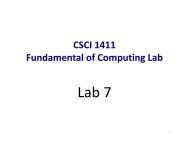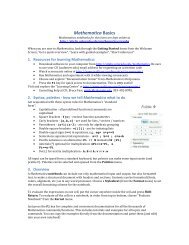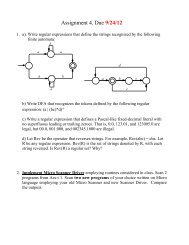[PDF] The Thickness and Chromatic Number of r - Gammeter.com
[PDF] The Thickness and Chromatic Number of r - Gammeter.com
[PDF] The Thickness and Chromatic Number of r - Gammeter.com
You also want an ePaper? Increase the reach of your titles
YUMPU automatically turns print PDFs into web optimized ePapers that Google loves.
which one edge <strong>of</strong> the perfect matching is on the 5-cycle <strong>and</strong> the other is one <strong>of</strong><br />
the spokes. This construction will then be applied to the r-inflation <strong>of</strong> the entire<br />
icosahedral graph.<br />
b<br />
c d<br />
x<br />
a<br />
Figure 3: Subgraph in I induced by one vertex <strong>and</strong> its five neighbors<br />
Consider the two edges xa <strong>and</strong> cd <strong>of</strong> the given matching in Figure 3. By Observation<br />
3, any edge in a graph G induces a K2r in G[r]. In particular, each <strong>of</strong> xa<br />
<strong>and</strong> cd induce a K2r in I[r]. We begin our construction by subdividing each <strong>of</strong> xa<br />
<strong>and</strong> cd with 2r − 2 vertices, which transforms each such edge into a path with 2r<br />
vertices. Let Pxa <strong>and</strong> Pcd be the paths resulting from the subdivisions <strong>of</strong> xa <strong>and</strong><br />
cd respectively. In preparation for the use <strong>of</strong> Lemma 1, label the vertices <strong>of</strong> Pxa in<br />
linear order so that<br />
Pxa = x1, x2r, x2, x2r−1, . . . , xi, x2r−(i−1), xi+1, . . . , xr, xr+1,<br />
where x = x1 <strong>and</strong> xr+1 = a. Similarly, label the vertices in path Pcd in linear order<br />
so that<br />
Pcd = c1, c2r, c2, c2r−1, . . . , ci, c2r−(i−1), ci+1, . . . , cr, cr+1,<br />
where c = c1 <strong>and</strong> cr+1 = d.<br />
Next add edges {xib, : i = 2, . . . , r}, {xib, : i = r + 2, . . . , 2r}, {xie, : i = 2, . . . , r},<br />
{xie, : i = r + 2, . . . , 2r}, {x1ci : i = 2, . . . , r}, <strong>and</strong> {x1ci : i = r + 2, . . . , 2r}. As<br />
previously mentioned, each edge <strong>of</strong> the given perfect matching uniquely determines<br />
a quadrilateral <strong>and</strong> therefore there is no ambiguity about which vertices <strong>of</strong> the 5-star<br />
are made adjacent to the vertices <strong>of</strong> the newly subdivided edges. Here xa determines<br />
bxea <strong>and</strong> so b <strong>and</strong> e are made adjacent to all new vertices <strong>of</strong> Pxa. Further, the<br />
quadrilateral determined by cd includes vertex x, <strong>and</strong> so x is made adjacent to all<br />
new vertices <strong>of</strong> Pcd. By design, the transformed 5-wheel remains planar; see Figure 4.<br />
<strong>The</strong> construction, when applied to all <strong>of</strong> the edges <strong>of</strong> the given perfect matching <strong>of</strong><br />
I, yields an edge maximal planar graph on 12r vertices, which we will denote by L1;<br />
see Figure 5. This “initial” planar graph together with the help <strong>of</strong> Lemma 1 will<br />
10<br />
e


![[PDF] The Thickness and Chromatic Number of r - Gammeter.com](https://img.yumpu.com/3978766/10/500x640/pdf-the-thickness-and-chromatic-number-of-r-gammetercom.jpg)





